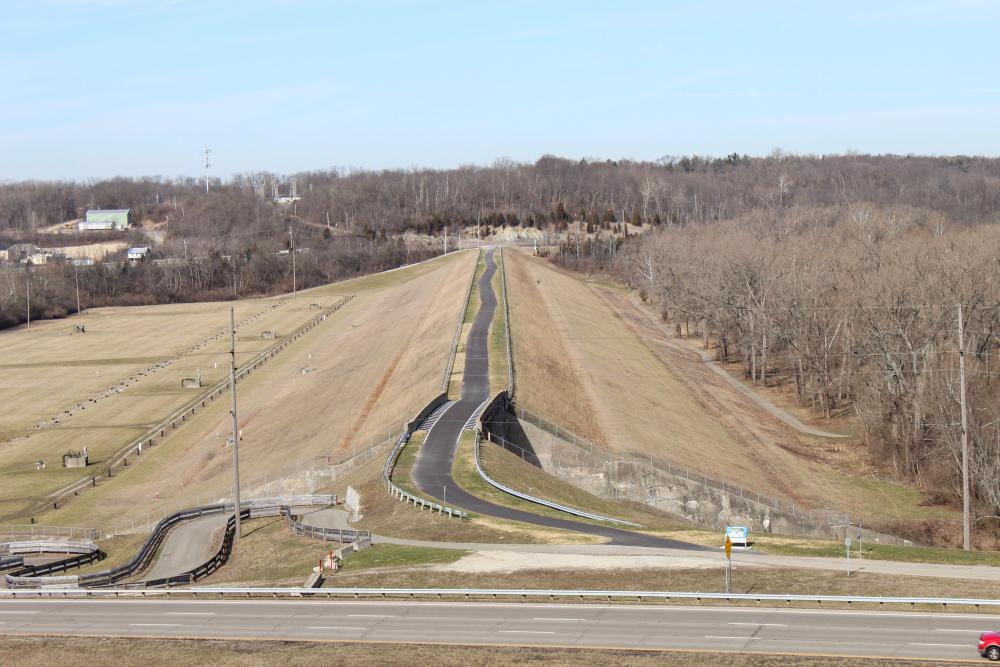More than 18,000 properties that sit downstream of a series of a century-old Ohio dam are at risk of flooding over the next three decades, according to climate data, as the Trump administration continues to roll back investments that would aid in keeping the waters at bay.
In a part of the US that’s largely flat, the view from above the Huffman dam in south-west Ohio is rare.
From the bike trail atop the dam, the shimmering lights of downtown Dayton appear to the south. Cargo planes from a nearby air force base circle overhead and water from the 66-mile-long Mad River gushes underfoot.
But the dam serves a far more pressing purpose: holding back up to 54bn gallons of water – enough to fill 82,000 Olympic-size swimming pools – during flooding events.
Nearby, more than 21% of all properties downstream are at risk of flooding over the next three decades, according to First Street, a climate risk data modeling organization. That percentage accounts for 18,596 properties in Dayton.
The five massive dry dams and 55 miles of levees west and north of Dayton were built in the aftermath of catastrophic destruction that befell the Ohio city in 1913, when 360 people died and flooding in three rivers that meet in the city center wiped out the downtown area.
But today, it and many other communities around the midwest are once again at risk of flooding.
“Our system has experienced 2,170 storage events. The flood in April ranked 12th,” says MaryLynn Lodor, general manager of the Miami Conservancy District, the authority overseeing the regional flood prevention system that includes the Huffman Dam. The flooding early last April saw five to seven inches of rain inundate homes, roads and parks, and caused power outages for thousands of people across hundreds of miles.
Extreme precipitation events are happening with increasing regularity at a time when, across a region that’s home to the country’s two major, high-discharge waterways – the Ohio and Mississippi rivers – decades-old flood prevention infrastructure is falling apart.
From Indiana, where authorities in charge of a dam at a youth camp that sees 15,000 visitors annually warned of failure during last April’s flooding, to Illinois and Minnesota, reports are appearing with increasing regularity of “100-year” floods threatening the integrity of, and in some cases destroying, dams.
Five years ago, the Edenville Dam in central Michigan failed following days of heavy rain, prompting the evacuation of 10,000 people and the failure of another dam downstream. The dam is situated at the confluence of two rivers, and in 2018 its owner temporarily had its license taken away due to fears it couldn’t pass enough water at high flood levels. Lawsuits and an expense report of $250m followed the dam failure.
Data from Michigan’s department of environment, Great Lakes and energy, found that of the state’s recorded 2,552 dams, nearly 18% were rated as in “fair”, “poor” or “unsatisfactory” condition.
Despite this, little change has been enacted in Michigan.
“The reason this is popping up everywhere in the country is because it’s a massive ageing infrastructure problem,” says Bryan Burroughs, a member of a now-closed state taskforce that sought to investigate the status of dams across Michigan following the Edenville incident.
He says the taskforce’s recommendations have largely not been enacted.
“To date, the only ones that have been taken up and addressed to any level are the ones that our state department of environment, Great Lakes and energy are able to oversee themselves. Regulatory changes have not been picked up legislatively,” Burroughs continued.
Through the Inflation Reduction Act, the Biden administration had made investing in America’s ageing infrastructure over the course of many years a priority, with $10bn dedicated to flooding mitigation and drought relief. An additional $3bn was allocated in 2021 through the Infrastructure Investment and Jobs Act for dam safety, removal and related upgrades.
Since Donald Trump entered the White House in January, the administration has vowed to roll back much of those investments. Hundreds of dam safety and other staffers working at dams in 17 western states have been laid off in recent months. Before the 4 July flood disaster in Texas, the Trump administration had pledged to close the Federal Emergency Management Agency (Fema). With more than 92,000 dams across the country, the Society of Civil Engineers estimates the cost of repairing the country’s non-federal dams at $165bn.
In Ohio, the Miami Conservancy District has been outspoken in highlighting that the dams it is responsible for are in need of repair – in particular, the upstream walls of two north of the city of Dayton. Levees it manages “are subject to the costly, federally mandated Fema accreditation process, but there is no adequate funding source.”
Last year, the district said it needs $140m to bring the region’s dams and levees up to safe levels over the coming decades. Over the past 80 years, the organization has seen a 228% increase in the volume of water its dams store, meaning the structures today must work harder than they did in the past to hold back the water.
“As we’re looking at having to make reinvestments, we are looking to try to secure some funding through the state and federal governments,” says Lodor.
“We have not gotten much support and federal dollars or state money to be able to do the system. It’s already been invested in by the local communities; it would be very difficult for this to be on the backs of the locals.”
Many dams hold back water that’s used by fishers and recreators – an issue that’s creating tension in many communities. In White Cloud, Michigan, authorities have had to draw down much of the lake water behind a 150-year-old dam due to fears for its structural integrity, angering locals.
As in Texas, dozens of youth groups and Christian camps across the midwest use lakes and waterways downstream of ageing lowhead and other dams for programming and outdoor activities. Emails and messages left by the Guardian with the owners of an at-risk dam at a camp in Indiana used by thousands of children every year received no response.
While compared with other parts of the US the midwest does not have a lot of dams whose main purpose is for flood control due to geological and topographical reasons, Ohio and much of the wider midwest have seen “record-setting rain” this year.
“The weather has changed,” says Burroughs. “What used to be a one-in-100-year flood event might have happened three times in the last 40 years.”

